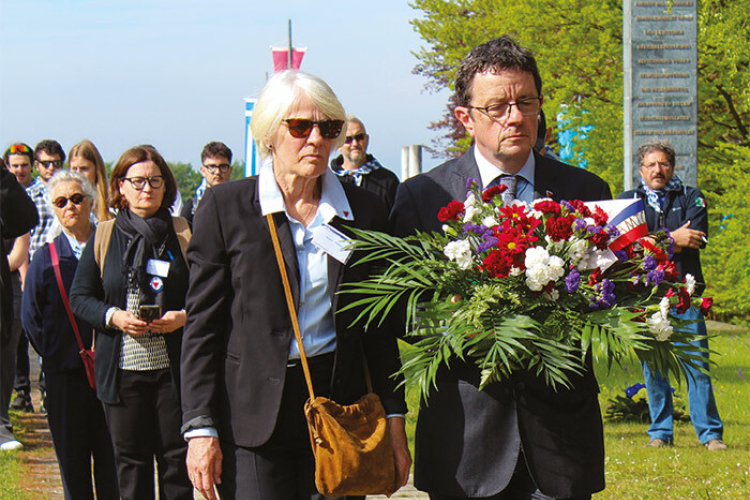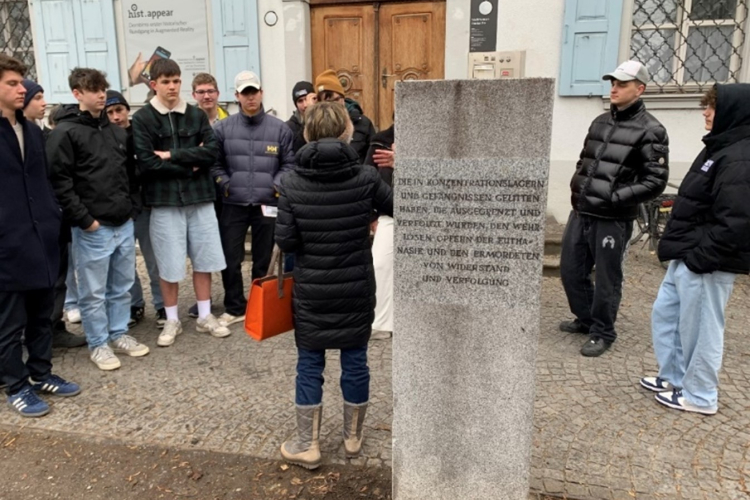The Significance of the 80th Anniversary of the Liberation of the Mauthausen Concentration Camp
15.04.2025

In April 1945, as the Allied troops approached, the SS began to erase the traces of their crimes. Facilities for the mass killings were dismantled, compromising documents were burned, and concentration camp prisoners were murdered.
On May 3, 1945, the last members of the SS fled from the Mauthausen and Gusen concentration camps. Two days later, on May 5, a US Army reconnaissance group arrived at the two camps. The following day, units of the 3rd US Army finally liberated around 40,000 prisoners.
On May 11, 2025, a significant and emotional event will occur in Mauthausen: Mauthausen Committee Austria, in cooperation with the International Mauthausen Committee (CIM), its 19 members, the Mauthausen Memorial, and the Gusen Memorial Committee will spotlight the 80th anniversary of the liberation of the Mauthausen concentration camp and its satellite camps.
The International Liberation Ceremony is an opportunity to commemorate the thousands of victims who suffered and lost their lives in this hellish environment during the Second World War. Simultaneously, this is an invitation to reflect on the values of human dignity, remembrance and resistance to oblivion, and emphasizes the importance of passing this history on to future generations. This event, which marks the beginning of a series of commemorations, is part of a collective process of remembrance and respect and a pledge that such atrocities must never be repeated.
What we commemorate on the 80th anniversary of the liberation of Mauthausen and its satellite camps
- We remember an event with many episodes that spanned several years and whose waves shook the world for decades – all the way to this decisive moment of liberation.
- We commemorate a trauma of enormous anthropological proportions, which the survivors tirelessly testified to the following generations – all the more urgently as fewer of them remained, for fear that their message would be lost with their deaths.
- And last but not least, we raise the question of the risk of recurrence and the persistence of the "radical evil" that created, organized and imposed a dystopian but functional and very real universe on its victims - a universe that aimed to preserve the domination of a supposed "master race" by degrading the rest of humanity into "sub-humans".
The event: liberation, horror and grief
Undoubtedly, this was about an intense and overwhelming feeling of regained freedom and the awareness that human dignity and fulfilment were at the heart of this. Alongside Stutthof and Theresienstadt, Mauthausen (May 5, 1945) and its satellite camps Ebensee (May 6) and Loibl Pass (May 7 and 8) were the last liberated camps to which concentration camp prisoners had been evacuated in death marches from the other large camps. On the muster ground, the arrival of several American vehicles was immediately perceived as the end of SS rule – as an opportunity for the prisoners, particularly through their International Committee, to regain control of their fate. They fought off the SS's last stand and rebuilt a starving but now liberated community of tens of thousands of men and women.
But the barely regained freedom was immediately accompanied by the terrifying realization of the scale of the catastrophe: Each liberated prisoner could count the number of his murdered comrades, but the full extent remained in the dark for a long time. Today we assume that around 100,000 people died, but the exact number is still unknown. And how could we ever mourn all those who died – alone, unknown, almost forgotten, especially in the last weeks of the winter and spring of 1945, when the mortality rate rose exponentially?
Eighty years later, the commemoration continues to encompass the joy of liberation, the horror of what was experienced, and the immeasurable grief for the lives lost, in an effort to comprehend in all its depth this terrifying cost to the freedom of our world today.
Processing the trauma: over a long period of time, through delegation and accompanied by fear
To this day, we are still trying to grasp the depth of the trauma, which cannot be fully represented by mere numbers. For beyond the summary (lynchings), formalized (Nuremberg Trials 1945 and, for Mauthausen, Dachau Trials 1947) and abstract judgments of history that the victims hoped for, it was a matter of reflecting on the injury inflicted on all of humanity vicariously via a multitude of prisoners of diverse origins, including some of its bravest representatives: Could people ever be healed when they were subjected to physical and mental torture every hour of every day for years, systematically aimed at eradicating their human existence?
When they returned to societies that were already swept away by the promise of economic resurrection, did they even have the opportunity to make their deep trauma understood? Who can describe the pain they felt when they had to resign themselves to being silent again after having been silenced or made to scream by force? And did we who eagerly listened to their words when the opportunity arose perceive their silence with equal attention?
Even now, in 2025, Amicale de Mauthausen is committed to ensuring that these women and men who have had the courage to express their opinions over the decades are read, heard and heeded.
The "still fertile womb": new alienations, unfulfilled longings and blocked horizons
Although 80 years have passed, there are still obstacles that prevent people from leading a life based on the ideals of the Mauthausen Oath. This oath was sworn in twelve different languages on 16 May 1945 on the muster ground of the liberated Mauthausen concentration camp and symbolizes the promise to fight against the atrocities of National Socialism and to stand up for a just and peaceful world. Time has not yet cleared away the old problems, and new problems are also blocking hope for a better future.
Is the vision of a "world of free people" still relevant and achievable today? There is no doubt that different assessments of this question have diverged over the course of European and global history, triggering political debates, including in our society.
Does it not therefore make sense to revisit the lessons learned in the immediate aftermath of liberation from Nazi hell, given that today political forces around the world - including in the heart of Europe, in the former Third Reich - are committed to the resurgence of nationalism and find it difficult to conceal a deep-rooted racism that has changed its target but continues to make explicit allusions to Nazi language, gestures, ideas and actions?
Some historians argue that the ideologies and administrative methods of the Nazis (especially in dealing with people as resources) have been incorporated into our modern societies. These references to the links between the past and the present must not be limited to the tragic role of Cassandra, i.e., seen as a cautionary but futile warning; instead, it must remain - today, in 2025, more than ever - the task of associations such as the Amicale to support the continuation of such analyses and to contribute to the political and social debate.
In 2025, the agenda of the Amicale de Mauthausen is a multi-layered expression of commemoration, of remembrance: it includes gratitude to the liberators, honoring those who died during the deportation and the survivors who tirelessly bore witness. Simultaneously, it raises profound questions about the historical weight of the concentration camps and challenges today's world to confront its tendency towards naivety, amnesia, denial or even the erasure of any historicity.
Jean-Louis Roussel
Vice president of Amicale de Mauthausen and Comité International de Mauthausen
Empfohlen

As a vocational school teacher at the provincial vocational school LBS Dornbirn 1, I have implemented several projects with apprentices. It is important to me that the apprentices learn about the history of the region during the Nazi era. I present a selection of projects below.
